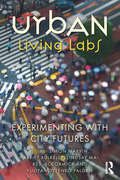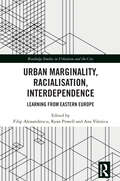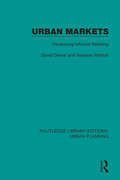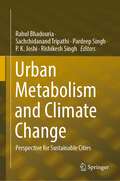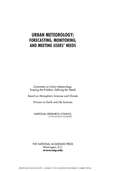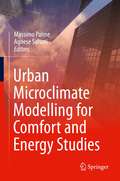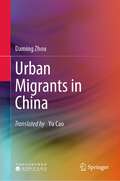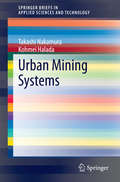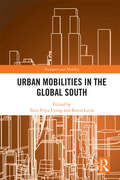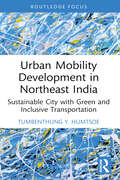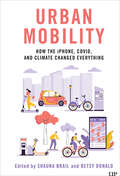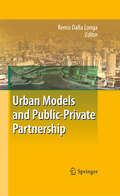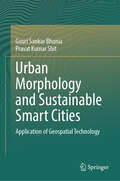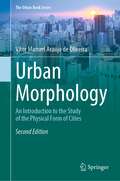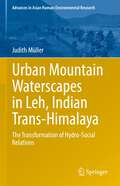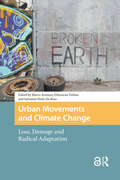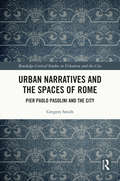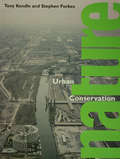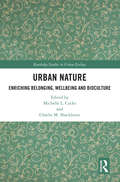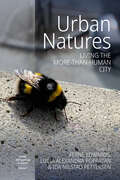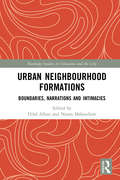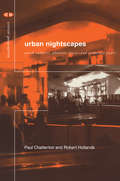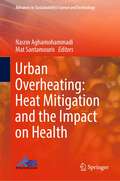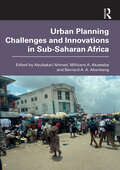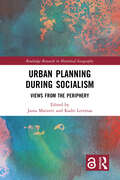- Table View
- List View
Urban Living Labs: Experimenting with City Futures
by Simon Marvin, Harriet Bulkeley, Lindsay Mai, Kes McCormick and Yuliya Voytenko PalganAll cities face a pressing challenge – how can they provide economic prosperity and social cohesion while achieving environmental sustainability? In response, new collaborations are emerging in the form of urban living labs – sites devised to design, test and learn from social and technical innovation in real time. The aim of this volume is to examine, inform and advance the governance of sustainability transitions through urban living labs. Notably, urban living labs are proliferating rapidly across the globe as a means through which public and private actors are testing innovations in buildings, transport and energy systems. Yet despite the experimentation taking place on the ground, we lack systematic learning and international comparison across urban and national contexts about their impacts and effectiveness. We have limited knowledge on how good practice can be scaled up to achieve the transformative change required. This book brings together leading international researchers within a systematic comparative framework for evaluating the design, practices and processes of urban living labs to enable the comparative analysis of their potential and limits. It provides new insights into the governance of urban sustainability and how to improve the design and implementation of urban living labs in order to realise their potential.
Urban Marginality, Racialisation, Interdependence: Learning from Eastern Europe (Routledge Studies in Urbanism and the City)
by Ryan Powell Filip Alexandrescu Ana VilenicaThis timely and interdisciplinary book deals with urban marginality as a multi-faceted process of urban transformation that engenders a wide range of experiences world-wide.Through the application of new empirical material and novel theoretical syntheses that exceed conceptual binaries (East-West, North-South), the authors explore shifting contemporary experiences of marginality in various urban contexts in Eastern Europe (EE). The unique articulation between global processes – such as gentrification, financialization, racialization and spatialization – and the distinctive histories, contestations and dislocations that characterize EE cities calls for increasing scholarly attention. The volume explores new patterns and drivers of urban marginality and racialization, and at the same time connects these to wider problematics of “advanced capitalist” cities as well as to post-socialist and anti-colonial urbanisms. The fourteen chapters contribute to a more nuanced understanding of global urbanism that decentres dominant Anglophone conceptualisations. Contributions focus empirically and theoretically on Czechia, Estonia, Hungary, Kosovo, Latvia, Lithuania, Romania, Serbia and Ukraine.The volume is recommended for students and urban scholars in EE and beyond, but will also be of interest to activists involved in housing and urban justice as well as in broader struggles towards the anti-racist city.
Urban Markets: Developing Informal Retailing (Routledge Library Editions: Urban Planning #8)
by Vanessa Watson David DewarOriginally published in 1990, Urban Markets looks at how the informal sector of the economy should be encouraged to assist in the alleviation of problems of poverty and unemployment. Despite this rhetoric, few concrete, implementable ways have been developed. This book is concerned with one such potential strategy which the authors consider to be particularly effective: the creation of both built and open markets for very small retailers and wholesalers. Based on experience of observing such markets in several continents, the authors combine a discussion of the theoretical issues surrounding the creation of urban markets with practical hints of how to establish and run them.
Urban Metabolism and Climate Change: Perspective for Sustainable Cities
by P. K. Joshi Pardeep Singh Rishikesh Singh Rahul Bhadouria Sachchidanand TripathiThis book provides a basic understanding and state-of-the-art of urban metabolism. Urban centres are increasingly challenged by population increase and the resultant environmental concerns including the urban sprawl and climate change. Different patterns of urbanization contribute to the changing climate via. differences in their urban metabolism represented by energy and matter. Urban metabolic studies in terms of energy and material inflows, outflows, and stocks can be associated with traditional evaluation techniques to help assess the magnitude and potential effects of variety of environmental challenges the world is facing today. Urban centres are critical real time observatories that indicate the impact anthropogenic activities have on global biogeochemical cycles. Urban processes have significant and lasting impacts on the global carbon budget. The technological and infrastructural advancements have fuelled an increase in urban inputs and outputs of material and energy. Therefore, more sustainable approaches need to be adopted in changing scenarios for urban planning, particularly for sustainable resource utilization and better waste management practices. The book emphasises on the sustainability in urban metabolism, sustainable urban planning, ecosystem services, and disaster resilience to provide an interdisciplinary understanding of urban metabolism. The book also identifies an urgent need to develop new methodological approaches for real time and reliable evaluation of urban metabolism.
Urban Meteorology: Forecasting, Monitoring, and Meeting Users' Needs
by Committee on Urban Meteorology: Scoping the Problem Defining The NeedsAccording to the United Nations, three out of five people will be living in cities worldwide by the year 2030. The United States continues to experience urbanization with its vast urban corridors on the east and west coasts. Although urban weather is driven by large synoptic and meso-scale features, weather events unique to the urban environment arise from the characteristics of the typical urban setting, such as large areas covered by buildings of a variety of heights; paved streets and parking areas; means to supply electricity, natural gas, water, and raw materials; and generation of waste heat and materials. Urban Meteorology: Forecasting, Monitoring, and Meeting Users' Needs is based largely on the information provided at a Board on Atmospheric Sciences and Climate community workshop. This book describes the needs for end user communities, focusing in particular on needs that are not being met by current urban-level forecasting and monitoring. Urban Meteorology also describes current and emerging meteorological forecasting and monitoring capabilities that have had and will likely have the most impact on urban areas, some of which are not being utilized by the relevant end user communities. Urban Meteorology explains that users of urban meteorological information need high-quality information available in a wide variety of formats that foster its use and within time constraints set by users' decision processes. By advancing the science and technology related to urban meteorology with input from key end user communities, urban meteorologists can better meet the needs of diverse end users. To continue the advancement within the field of urban meteorology, there are both short-term needs-which might be addressed with small investments but promise large, quick returns-as well as future challenges that could require significant efforts and investments.
Urban Microclimate Modelling for Comfort and Energy Studies
by Massimo Palme Agnese SalvatiThis book discusses urban microclimate and heat-related risks in urban areas, brought on by the combination of global climate change effects and local modification of climate determined by extensive urbanization such as the ‘Urban heat island’ phenomenon. This matter is relevant to almost all urbanized areas in the world, where the increase of urban population and air temperature is expected to endanger both the overall health of the population and the energy supply for the functioning of urban systems. The book details the inter-relationship between urban morphology, microclimate and building energy performance and presents a multidisciplinary approach that brings together Urban Climatology, Engineering and Architectural knowledge to support the development of reliable models and tools for research and practice. This book is a useful tool for architects and building energy modelers, urban planners and geographers who need a practical guide to realize basic urban microclimate simulation for use in both academic research and planning practice.
Urban Migrants in China
by Daming ZhouThis book focuses on the background, migration, and settlement of new migrants in China. It also examines the status of their social networks, the role of urban society, social security, and future planning. Based on semi-structured interviews, the book analyzes these aspects of new urban migrants and argues that:- Intellectual migrants, with their strong educational background, are willing to engage in urbanization and have clear entry strategies.- Labor migrants find it is challenging for labor migrants to receive the same welfare as citizens and they are subject to significant segregation in urban societies due to existing policies and market economy conditions.- Operational migrants have stronger settlement and family-oriented tendencies compared to labor migrants.
Urban Mining Systems
by Takashi Nakamura Kohmei HaladaThis book focuses on the fundamental concept of and current endeavors in "urban mining" among those who are interested in both metal resources and ecology. Systems for recycling and reusing precious metals and rare-earth minerals contained in used and discarded electronics are introduced in this book. The target audience is not academic researchers in the resource management and ecology fields but, rather, citizens who are concerned about our future environment and want to do something for the future.
Urban Mobilities in the Global South (Transport and Mobility)
by Karen Lucas Tanu Priya UtengThe book considers urban mobilities and immobilities in the Global South through an exploration of the theoretical and methodological entry points that can be used to further the agenda of transport planning. Transport system improvements can (and do) have complex and unequal impacts on different sectors of society. Conventional approaches to analysing travel demand and transport system performance developed in the ‘Global North’ are typically ill-equipped to identify and understand the complexities and inequities in urban areas of the Global South. Using case studies from urban Africa and Asia, the book addresses the need to understand the ‘lived world’ of mobilities and use this knowledge to address issues that are central to our urban existence in the 21st century.
Urban Mobility Development in Northeast India: Sustainable City with Green and Inclusive Transportation (Routledge Contemporary South Asia Series)
by Tumbenthung Y. HumtsoeUrban Mobility Development in Northeast India theoretically and empirically explores the interrelationship between and among city, transportation, economic growth and environment to contribute towards engendering green urbanization for green growth.In a time of aggravating environmental crisis, the book recognizes the duality of contrasting impact of city and transport to economic development and environmental degradation. To serve as a guide for policy research, the book accessibly presents a contextual study blending qualitative as well as quantitative methodology in the context of a highland as well as a frontier capital city of the Northeastern Indian state of Nagaland, Kohima, towards creating a sustainable city with an inclusive and green mobility. The book underscores that management of urbanization and urban mobility challenges should go beyond supply side management and demand side management by democratizing policy making as well as considering efficiency, equity, welfare and practicality concerns and suchlike rationales.By traversing from abstraction to everyday life, from global context to frontier context and from macro level to micro level, the book makes significant theoretical as well as empirical contribution. The book will be of use to students, researchers, policy practitioners as well as general readers interested in Urban Studies, Transport Economics, Growth Economics, Development Studies, Environmental Studies and Asian Studies, especially in relation to highland and frontier regions in developing economies in general and Northeastern Region of India in particular.
Urban Mobility: How the iPhone, COVID, and Climate Changed Everything
by Shauna Brail Betsy DonaldUrban Mobility sheds light on mobility in twenty-first-century Canadian cities. The book explores the profound changes associated with technological innovation, pandemic-induced impacts on travel behaviour, and the urgent need for mobility to respond meaningfully to the climate crisis. Featuring contributions from leading Canadian and American scholars and researchers, this edited collection traverses disciplines including geography, engineering, management, policy studies, political science, and urban planning. Chapters illuminate novel research findings related to a variety of modes of mobility, including public transit, e-scooters, bike-sharing, ride-hailing, and autonomous vehicles. Contributors draw out the connections between urban challenges, technological change, societal need, and governance mechanisms. The collection demonstrates why the smart phone, COVID-19, and climate present a crucial lens through which we can understand the present and future of urban mobility. The way we move in cities has been disrupted and altered because of technological innovation, the lingering impacts of COVID-19, and efforts to reduce transport-related emissions. Urban Mobility concludes that the path forward requires good public policy from all levels of government, working in partnership with the private sector and non-profits to direct and address the best urban mobility framework for Canadian cities.
Urban Models and Public-Private Partnership
by Remo Dalla LongaThis book addresses the topic of urban models with reference to large western cities and particularly to global cities. In the current transitional phase, the use of language and the systematization of phenomena has become important. The book's matrix examines two important and strongly connected themes: urban models and public-private partnerships (PPP) determined by urban functions which are transformed in an increasingly rapid and complex manner as a result of globalization. PPPs represent the new border of the modern global state. The book focuses on two principal urban models (renewal and restructuring) through PPPs and subsequently the relationship between state and market in fourteen Italian cities (renewal) and two central European cities, Leipzig and Budapest (restructuring). CoUrbIT (Complex Urban Investment Tools) and the book 'Globalization and Urban Implosion: Creating New Competitive Advantage' by the same author serve as points of reference.
Urban Morphology and Sustainable Smart Cities: Application of Geospatial Technology
by Gouri Sankar Bhunia Pravat Kumar ShitAs cities swell and the pressure on urban infrastructure intensifies, the concept of the Smart City emerges not merely as an ideal but as a necessity. This groundbreaking volume offers an in-depth, multidisciplinary journey through the evolving landscape of urbanization and sustainable smart city development. This book offers a thorough description of the challenges posed by increasing global urbanization. Unplanned urbanization gave rise to the change of urban land use patterns, slums, inadequate housing, sanitation hazards, rampant pollution, and the rise of global epidemics. It focuses in particular on strategies and services to solve the difficulties and concerns raised by increasing urbanization. This book demystifies the smart city, not just as a technological aspiration, but as a living, breathing urban ecosystem. Starting with foundational concepts and global case studies, it journeys through the multilayered dimensions of smart governance, intelligent transport systems, resilient infrastructure, citizen participation, and data-driven decision-making.In addition, the contributors will take insights from environmental design, geography, strategic planning, application of science and technology, and engineering design to go beyond the jargon of technical innovation and expose the political, social, and physical effects of digitalizing the world in smart cities. This book highlights the planning of land use, strategic development, and ecosystem-based knowledge to enhance economic growth and a healthy urban environment, and smart city management, the contradictory aspects of smart city studies, and provides useful insights into the creation and execution of policies to strengthen decision-making processes in smart cities. This book uniquely blends academic rigor with real-world applications, including over a dozen case studies from Indian and international contexts—ranging from slum infrastructure upgrading in Bankura to geospatial tree mapping in Pune and density-based service analysis in Bengaluru and Delhi.In addition, the book leads the reader to a greater understanding of smart city growth, both theoretical and realistic. Designed for urban planners, researchers, civil engineers, geographers, policy strategists, and students, Urbanization and Sustainable Smart Cities offers both a strategic roadmap and a technological toolkit for those envisioning the smart cities of tomorrow—equitable, green, digitally empowered, and resilient.
Urban Morphology: An Introduction to the Study of the Physical Form of Cities (The Urban Book Series)
by Vítor Manuel Araújo de Oliveira'This is a textbook about cities or, more precisely, about the physical form of cities. It provides an overview of the main elements of urban form—streets, street blocks, plots and buildings—structuring our cities and the fundamental agents and processes of transformation shaping these elements. It applies this analytical framework to describe the evolution of cities over history as well as to explain the functioning of contemporary cities. After the initial focus on the 'object' (cities), the book introduces how different schools of thought have been dealing with this object since the emergence of Urban Morphology, as the science of urban form, in the turning to the twentieth century. Finally, the book identifies the main contributions of urban morphology to cities, societies and economies. This second edition of the book offers updated and more accurate knowledge on several morphological issues, presents expanded contents, and it has a more explicit didactic nature, including a set of exercises in the end of each chapter, that will help teachers and students (in architecture, geography, planning, history, sociology and urban studies) in acquiring and consolidating their urban morphological knowledge.
Urban Mountain Waterscapes in Leh, Indian Trans-Himalaya: The Transformation of Hydro-Social Relations (Advances in Asian Human-Environmental Research)
by Judith MüllerThe city of Leh is located in the high mountain desert of Ladakh in the Indian Himalayas and access to water has always been limited there. In recent years, the town has experienced high rates of urbanisation on the one hand, and tourist numbers have increased exponentially on the other, which has implications for the water supply of the people living there. Through several years of on-site research, challenges on various levels were documented and current governance approaches were analysed. This research forms the basis for future approaches to sustainable development.
Urban Movements and Climate Change: Loss, Damage and Radical Adaptation (Protest and Social Movements)
by Marco Armiero Ethemcan Turhan Paolo De Rosa, SalvatoreFrom the social uprisings in Santiago de Chile to the radical municipalism experiments in Naples, this volume takes the reader on an intellectual journey at the frontlines across global South and global North where climate breakdown meets social innovations. While the effects of the climate crisis are becoming more extreme and tangible across the globe with every passing day, urban social movements and their radical strategies to resist climate injustice often remain concealed from sight. Contributors to this volume ask how would it be to look at the politics of urban loss-and-damage not from the highly securitized zones of climate summits, but from favelas in Rio de Janeiro, flood-prone communities in São Paulo, urban gardens in Naples, or neighborhoods resisting climate gentrification in New York City? This book explores diverse worlds and praxis of urban social movements resisting the rising tides of climate crisis and social injustice.
Urban Narratives and the Spaces of Rome: Pier Paolo Pasolini and the City (Routledge Critical Studies in Urbanism and the City)
by Gregory SmithThis book foregrounds the works of Pier Paolo Pasolini to study the Roman periphery and examine the relevance of Pasolini’s vision in the construction of subaltern identity and experience. It analyses the contemporary Italian society to understand the problem of social exclusion of marginal communities. Narrative studies are at the core of the contemporary social science research. This book uses narrative analysis to unpack the deeper meaning of Rome’s stigmatized periphery through an interplay of Italian cinema, literature, and social and political climates. It encourages a positive interpretation of the Roman periphery through its characterization as a homogeneous area of marginality as emphasized in Pasolini’s writings and films on Rome. This re-evaluation left a lasting impact on the modern periphery and the narratives of ordinary citizens as evident in contemporary street art and popular musical production. Pasolini’s revolutionary vision allows us to appreciate the human and aesthetic character of urban life in regions beyond the main urban areas. The respect for subaltern urban communities encouraged by this book can be extended from Rome to other parts of the world. This book presents an interconnection of social theory, geography, poetry, literature, film and the visual arts to study the experience of life in underprivileged urban areas. Written in an accessible style, the book offers a reimagining of the Roman periphery which will appeal to readers in France, Spain, Italy, Australia, areas which have significant interest in Italian studies and the works of Pasolini.
Urban Nature Conservation: Landscape Management in the Urban Countryside
by Stephen Forbes Tony KendleUrban nature conservation is a field that has grown rapidly in importance over the past 20 years and will continue to do so in the coming years as landscape ecology and greenspace planning become established disciplines. A widespread concern and interest in the wild plants and animal life found in urban areas now influences the policies and practices of land management organizations. This book provides a comprehensive overview of the subject. It will assist professionals in formulating strategic management policies that integrate urban nature conservation into the wider context of landscape management and urban planning.
Urban Nature: Enriching Belonging, Wellbeing and Bioculture (Routledge Studies in Urban Ecology)
by Michelle L. Cocks and Charlie M. ShackletonThis book showcases the diversity of ways in which urban residents from varying cultural contexts view, interact, engage with and give meaning to urban nature, aiming to counterbalance the dominance of Western depictions and values of urban nature and design. Urban nature has up to now largely been defined, planned and managed in a way that is heavily dominated by Western understandings, values and appreciations, which has spread through colonialism and globalisation. As cities increasingly represent a diversity of cultures, and urban nature is being increasingly recognised as contributing to residents' wellbeing, belonging and overall quality of life, it is important to consider the numerous ways in which urban nature is understood and appreciated. This collection of case studies includes examples from Africa, Asia, Europe, North and South America, and reflects on the multi-dimensional aspects of engagements with urban nature through a biocultural diversity lens. The chapters cover several themes such as how engagements with nature contribute to a sense of wellbeing and belonging; the implications that diversity has on the provision, design and management of urban environments; and the threats inhibiting residents’ abilities to engage meaningfully with nature. The book challenges the dominant discourse, Western ideological understandings and meta-narratives of modernisation and unilineal urban transitions. A timely addition to the literature, Urban Nature: Enriching Belonging, Wellbeing and Bioculture offers an alternative to Western ideological understandings of nature and values and will be of great interest to those working in human and environmental urban ecology. It will also be key reading for students in the relevant fields of anthropology, development studies, geography, social ecology and urban studies.
Urban Natures: Living the More-than-Human City (Urban Anthropology Unbound #1)
by Ida Nilstad Pettersen Ferne Edwards, Lucia Alexandra PopartanEfforts to create greener urban spaces have historically taken many forms, often disorganized and undisciplined. Recently, however, the push towards greener cities has evolved into a more cohesive movement. Drawing from multidisciplinary case studies, Urban Natures examines the possibilities of an ethical lively multi-species city with the understanding that humanity’s relationship to nature is politically constructed. Covering a wide range of sectors, cities, and urban spaces, as well as topics ranging from edible cities to issues of power, and more-than-human methodologies, this volume pushes our imagination of a green urban future.
Urban Neighbourhood Formations: Boundaries, Narrations and Intimacies (Routledge Studies in Urbanism and the City)
by Hilal Alkan Nazan MaksudyanThis book examines the formation of urban neighbourhoods in the Middle East, Africa, and South Asia. It departs from ‘neighbourhoods’ to consider identity, coexistence, solidarity, and violence in relations to a place. Urban Neighbourhood Formations revolves around three major aspects of making and unmaking of neighbourhoods: spatial and temporal boundaries of neighbourhoods, neighbourhoods as imagined and narrated entities, and neighbourhood as social relations. With extensive case studies from Johannesburg to Istanbul and from Jerusalem to Delhi, this volume shows how spatial amenities, immaterial processes of narrating and dreaming, and the lasting effect of intimacies and violence in a neighbourhood are intertwined and negotiated over time in the construction of moral orders, urban practices, and political identities at large. This book offers insights into neighbourhood formations in an age of constant mobility and helps us understand the grassroots-level dynamics of xenophobia and hostility, as much as welcoming and openness. It would be of interest for both academics and more general audiences, as well as for students of undergraduate and postgraduate courses in Urban Studies and Anthropology.
Urban Nightscapes: Youth Cultures, Pleasure Spaces and Corporate Power
by Paul Chatterton Robert HollandsIn many western cities, urban nightlife is experiencing a 'McDonaldisation', where big branded names are taking over large parts of downtown areas, leaving consumers with an increasingly standardised experience. This book takes a new look at this rapidly changing aspect of urban life, examining the relationships between young adults, nightlife and city spaces. It focuses on what the authors call 'urban nightscapes' - both mainstream and alternative youthful cultural activities in bars, pubs, night-clubs and music venues, which occur against a backdrop of increasing corporate influence in the night-time economy.
Urban Overheating: Heat Mitigation and the Impact on Health (Advances in Sustainability Science and Technology)
by Mat Santamouris Nasrin AghamohammadiThe book reviews and reports the recent progress and knowledge on the specific impact of current and projected urban overheating as well as of the urban mitigation technologies on mortality and morbidity and urban vulnerability. It presents recent data and developments on the topic reported by some of the more distinguished researchers in this area. In parallel, it discusses new findings related to the characteristics and the magnitude of urban overheating and reports and analyzes the recent knowledge on the synergies between urban heat island and heatwaves. This book helps to advance our understanding on the interaction between Urban Heat Island (UHI) and overheating as well as their impact on energy demand and public health globally. Exploring the interaction between UHI and energy consumption requires the understanding on the dynamics of UHI intensity and air pollution index in different land use and how such interactions may vary in different cities in the world. Moreover, this book focuses on different cities in Australia, Austria, Belgium, Brazil, Canada, Cyprus, Greece, Hong Kong, India, Asia, Spain, UK, and USA.
Urban Planning Challenges and Innovations in Sub-Saharan Africa
by Abubakari AhmedUrban planning practice in Sub-Saharan Africa increasingly encounters complexities due to the confluence of urbanisation, climate change, and their interconnected drivers and consequences. The potential effect of these complexities on achieving the sustainable development goals is significant. This book explores the unique challenges faced by rapidly growing cities in Sub-Saharan Africa, including urban crime, informality, land governance, development control, and the degradation of green spaces, as well as how these issues are addressed in planning education and emerging innovations. The book presents various case studies from selected African countries, emphasising contemporary urban challenges and innovative strategies, including implementing artificial intelligence, which is being adopted to tackle these issues. Chapters analyse the significance of reflective planning, hybrid governance, international development, and technological advancements in influencing the future trajectory of urban development planning.By providing a comprehensive overview of these issues, this book serves as a crucial resource for urban planners, policymakers, scholars, and students dedicated to the sustainable development of cities in Sub-Saharan Africa.
Urban Planning During Socialism: Views from the Periphery (Routledge Research in Historical Geography)
by Jasna Mariotti Kadri LeetmaaUrban Planning During Socialism delves into the evolution of cities during the period of state socialism of the 20th century, summarizing the urban and architectural studies that trace their transformations. The book focuses primarily on the periphery of the socialist world, both spatially and in terms of scholarly thinking. The case study cities presented in this book draw on cultural and material studies to demonstrate diverse and novel concepts of ‘periphery’ through transformations of socialist cityscapes rather than homogenous views on cities during the period of state socialism of the 20th century. In doing so the book explores the transversalities of political, economic, and social phenomena; the places for everyday life in socialist cities; the role of professional communities on production and reproduction of space and ecological thinking. This book is aimed at scholarly readership, in particular scholars in architecture, urban planning, and human geography, as well as undergraduate, graduate, and post-graduate students in these disciplines studying the urban transformation of cities after World War II in socialist countries. It will also be of interest for planning officials, architects, policymakers and activists in former socialist countries.
